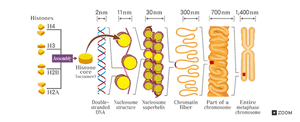Nucleus and nucleolus – structure and function
The Nucelus
The nucleus serves as the repository for the cellular blueprint, encapsulating all instructions for cell structures and activities encoded within the DNA of the chromosomes. Additionally, it harbors the molecular machinery necessary for DNA replication and the synthesis and processing of various types of RNA. Regulation of macromolecular transfer between the nuclear and cytoplasmic compartments occurs within the nucleus, with the proteins required for its functionality imported from the cytoplasm.
Typically oval in shape and centrally located within the cell, the nucleus comprises several key components, including the nuclear envelope, chromatin (comprising DNA and associated proteins), and a specialized region known as the nucleolus.
The Nuclear envelope consists of two membrane layers surrounding the nucleus, separated by a narrow perinuclear space measuring approximately 30-50nm. The outer portion of the envelope serves as a direct extension of the endoplasmic reticulum, while the inner portion, known as the nuclear lamina, consists of fibrous proteins—primarily intermediate filament proteins called lamins—that contribute to stabilizing the nuclear envelope. At sites where the inner and outer membranes of the nuclear envelope merge, lipid-free spaces containing nuclear pore complexes, or nucleoporins, facilitate most bidirectional transport between the nucleus and the cytoplasm.
Chromatin:
Chromatin is the chromosomal material in a largely uncoiled state. Two types of chromatin can be distinguished under the EM or LM:
Heterochromatin - The condensed structure of DNA, characterized by its tightly packed form, is associated with various functions ranging from gene regulation to the preservation of chromosome integrity. Many of these functions can be attributed to the dense packing of DNA.
Euchromatin represents the less densely packed form of chromatin, consisting of DNA, RNA, and protein, and is characterized by a high concentration of genes, typically undergoing active transcription, though not universally. Euchromatin constitutes the most dynamically active region of the genome within the cell nucleus, with approximately 92% of the human genome being euchromatic, while the remaining portion is referred to as heterochromatin.
Chromatin primarily consists of DNA strands coiled around basic proteins known as histones, along with various non-histone proteins. The fundamental structural unit of chromatin is the nucleosome, which comprises a core formed by eight small histones (two copies each of H2A, H2B, H3, and H4), surrounded by approximately 150 base pairs of DNA. Additionally, each nucleosome includes a larger linker histone (H1), which binds both the wrapped DNA and the core's surface. Subsequently, DNA bound to nucleosomes undergoes further folding in the next level of chromatin organization known as the 30nm fiber. This hierarchical organization continues, leading to higher orders of chromatin coiling, eventually forming microscopically visible stained structures called chromosomes. Chromosomes play a crucial role in the condensation of chromatin during processes such as mitosis and meiosis.
8 Histones with DNA wrapped = Nucleosome - Chromatin - Chromosome
Important* - The chromatin pattern within a nucleus reflects the cell's level of activity. Typically, cells with lightly stained nuclei exhibit higher activity in protein synthesis compared to those with condensed, dark nuclei. In nuclei with light staining, characterized by abundant euchromatin (loosely packed chromatin conducive to transcription for subsequent protein synthesis) and minimal heterochromatin, a larger DNA surface area is accessible for RNA transcription.
Sex chromatin:
In males, each cell typically contains one X chromosome and one Y chromosome, while females typically have two X chromosomes. These X and Y chromosomes carry genes that determine an individual's sex, dictating whether they develop as male or female. In most human somatic cells, which comprise the majority of the body's cells, there are 22 pairs of autosomes along with one pair of sex chromosomes. Each of these 23 pairs of chromosomes consists of one chromosome inherited from the mother and one from the father. These paired chromosomes are known as homologous chromosomes because, despite originating from different parents, they contain variants (alleles) of the same genes. Somatic cells are classified as diploid (2N chromosomes – 46) due to having two sets of chromosomes, while sperm and mature oocytes are haploid (N chromosomes – 23) because they only contain one set of chromosomes. This haploid condition is achieved through the separation of each chromosome pair during meiosis. The arrangement and characteristics of chromosomes present in an individual are referred to as their karyotype.
The Nucleolus resides within the nuclei of cells engaged in protein synthesis. Its pronounced basophilia arises not from heterochromatin, but from the dense concentration of ribosomal RNA (rRNA) molecules. These rRNA molecules undergo transcription, processing, and complexing into ribosomal subunits within this nuclear region. The rRNA molecules synthesized and altered in the nucleolus promptly bind with numerous ribosomal proteins, which are transported from the cytoplasm through nuclear pore complexes. Subsequently, the newly assembled small and large ribosomal subunits are exported back to the cytoplasm via these nuclear pores.

